Livebearers are vibrant, adaptable, and fascinating fish, ideal for both novice and experienced aquarists. They’re named for their unique reproductive style, as females give live birth rather than laying eggs. The species include guppies, mollies, platies, and swordtails, among others, each boasting different colours and patterns.
This guide will take you through their varieties, habitat setup, care instructions, diet, compatibility with other fish, and breeding tips. Our goal is to help you provide the best environment for your livebearer fish and allow you to fully enjoy the rewarding experience of keeping these wonderful creatures.
Table of Contents
What Are Livebearers?
Livebearers are a captivating group of fish, named for their unique trait: they give birth to live fry rather than laying eggs. This category includes popular species like guppies, mollies, platies, and swordtails.
These vibrant swimmers hail from various habitats, from tranquil Central American ponds to dynamic Caribbean estuaries. In an aquarium, they bring a burst of colour and life, and observing their birth process is a remarkable spectacle. However, their care involves understanding their unique needs and emulating their natural environments.
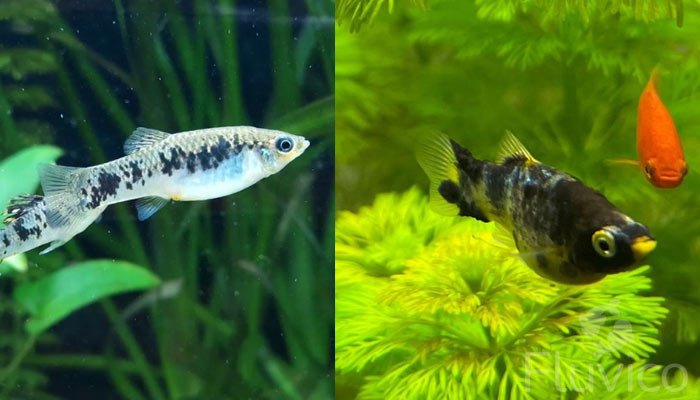
Livebearers Facts & Overview
Livebearers are a diverse and intriguing group of fish, celebrated for their reproductive system where they bear live young rather than laying eggs. Check out these quick facts about them:
- Species Inclusion: Livebearers encompass fan favourites like guppies, mollies, platies, and swordtails.
- Visual Appeal: With a plethora of colours, patterns, and sizes, they add visual interest to any aquarium.
- Natural Habitats: They’re native to a wide range of environments, from Central American freshwater ponds to Caribbean brackish estuaries.
- Hardiness: Generally resilient and adaptable, livebearers are suitable for both novice and seasoned aquarists.
- Care Requirements: Proper care demands an understanding of their specific needs, such as water parameters, diet, and tank mates.
- Unique Experience: Observing the birth process of livebearers offers an unparalleled, enriching experience for fish keepers.
Origin
Livebearers originate from diverse habitats spanning across the Americas, from the southern United States to Brazil. You’ll find them in everything from slow-moving freshwater streams to brackish coastal estuaries. But here’s a fascinating titbit: some species, like the Mangrove Rivulus, exhibit a unique survival strategy called ‘selfing.’ In the absence of mates, these hermaphroditic fish can self-fertilize, essentially cloning themselves to ensure their lineage continues.
This rare evolutionary adaptation, along with their ability to temporarily live out of water, has allowed them to populate environments that many other fish species simply can’t handle. That’s the kind of resilience and adaptability livebearers are celebrated for!

Livebearer Varieties
Livebearers encompass a range of species, each one bringing its own unique charm and characteristics to an aquarium. Here are some popular varieties:
- Guppies (Poecilia reticulata): Perhaps the most recognized livebearer, guppies are small and colorful, with males exhibiting flamboyant, fan-like tails. Their vibrant hues and patterns can vary extensively.
- Mollies (Poecilia sphenops): Known for their elongated bodies and pointed dorsal fins, mollies come in many colors and varieties, including the popular Black Molly and Sailfin Molly.
- Platies (Xiphophorus maculatus): Sporting bright colors and a more rounded body, platies are a favorite choice among beginners due to their hardiness.
- Swordtails (Xiphophorus hellerii): As the name suggests, male swordtails are known for their long, sword-like tail extensions. They come in many colors, with the red and green varieties being particularly popular.
- Endler’s Livebearers (Poecilia wingei): These are close relatives of guppies and share similar vibrant colors and patterns, but are generally smaller in size.
Adult Size & Lifespan
The size and lifespan of livebearer fish can vary greatly depending on the species.
- Guppies, one of the smallest types of livebearers, typically grow to about 2.5 inches in length, with females often being slightly larger than males. They usually have a lifespan of 2-3 years in optimal conditions.
- Mollies, a slightly larger species, can grow up to 5 inches in length. Under good care, mollies can live for around 3-5 years.
- Platies and swordtails are similar in size, typically growing to about 2-2.5 inches and 4-5 inches respectively. They also share a similar lifespan, usually living for 3-5 years in a well-maintained aquarium.
These estimates, of course, can vary based on factors such as diet, tank conditions, and genetics. Proper care and maintenance can help maximize their lifespan and ensure a high quality of life.

Should You Get a Livebearer for Your Aquarium?
Deciding to introduce livebearers to your aquarium is an exciting decision! They’re captivating creatures, boasting vivid colors, fascinating behaviors, and a unique reproductive system. They can be a joy to observe and maintain, but here are a few considerations:
- Experience level: Livebearers are generally hardy and adaptable, making them a great choice for both novice and seasoned aquarists.
- Aquarium conditions: They thrive in well-maintained aquariums that mimic their natural habitat. You’ll need to ensure proper water conditions, temperature, and filtration.
- Tank space: Some livebearers stay small, but others grow larger and may need more swimming space. Always consider the size and compatibility of the fish species with your tank size.
- Diet: They typically eat a wide range of foods, including commercial flakes and live foods. Consider if you can provide a varied and nutritious diet.
- Breeding: Livebearers breed quite readily. If you’re not prepared to handle the offspring, you might need a plan to control their population.
Appearance & Behavior
Appearance:
- Vibrant Colors: Livebearers are well-known for their brilliant colors and patterns. From the multi-colored guppies to the sleek black mollies, they bring a splash of color to any aquarium.
- Size Variation: Depending on the species, their size can range from the tiny 1.5-inch guppy to the larger 5-inch molly.
- Unique Traits: Some livebearers have standout features, like the swordtail’s long, sword-like tail extension, or the endler’s radiant color palette.
Behavior:
- Active Swimmers: Livebearers are often seen darting around the tank, making them engaging to watch.
- Community-Oriented: Most livebearers are peaceful and thrive in community tanks. However, they do best with their own kind or other similarly sized, non-aggressive species.
- Breeding Behavior: Livebearers reproduce readily and often. Females can store sperm from a single mating, resulting in several batches of fry over time.
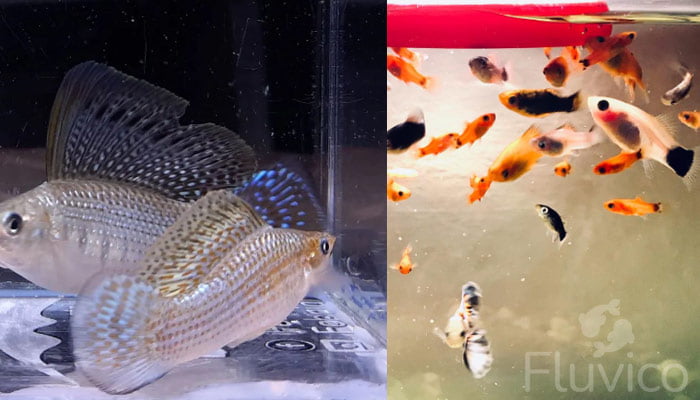
Male Vs Female Differences
In livebearer species, there are several distinguishing features that can help differentiate males from females:
- Size: In many livebearer species, females are usually larger than males. This is true for guppies, mollies, platies, swordtails, and Endler’s livebearers.
- Coloration: Males are generally more colorful and have more striking patterns than females. This difference is particularly noticeable in species like the guppy and Endler’s livebearer, where males display a vibrant array of colors, while females are more subdued.
- Shape: Females often have rounder bodies, especially when they are pregnant, as they carry the fertilized eggs internally before giving birth to live young. Males, on the other hand, tend to have slimmer bodies.
- Anal Fin: The male’s anal fin, also known as the gonopodium, is modified for insemination and is usually long, thin, and pointed. Females have a more standard, fan-shaped anal fin.
These distinctions are key to understanding your livebearers better and managing their reproduction effectively in your aquarium.

Livebearers care
Housing Requirements for Livebearers
Housing requirements for livebearers can vary by species, but here are some general guidelines:
Tank Size: The tank size depends on the livebearer species and the number of fish. For smaller species like guppies and Endler’s livebearers, a 10-gallon tank is a good starting point. Larger species like mollies and swordtails require more space – a 20 to 30-gallon tank is often recommended.
Water Parameters: Livebearers generally prefer slightly alkaline water with a pH between 7.0 and 8.0. Water hardness can vary, but many species prefer moderately hard water. The ideal temperature ranges between 70°F and 80°F, though some species may tolerate slightly warmer or cooler conditions.
Substrate & Decorations
When setting up an aquarium for livebearers, choosing the right substrate and decorations can make a significant difference to the health and wellbeing of your fish:
Substrate:
- Most livebearers thrive in environments with sand or fine gravel as a substrate. The choice between the two depends on your aesthetic preference and the natural habitat of the specific livebearer species you’re keeping.
- Darker substrates can often accentuate the vibrant colors of your livebearers, making them stand out more in the aquarium.
Decorations:
- Livebearers enjoy exploring and hiding in their environment, so adding rocks, caves, driftwood, or other similar aquarium-safe decorations can provide them with a sense of security and comfort.
- Live plants not only beautify your tank but also offer plenty of hiding spots for your fish. They can help improve water quality by absorbing nitrates and providing oxygen. Examples of suitable plants for a livebearer tank include Java fern, Anubias, and Vallisneria.
- Make sure there’s enough open space for your livebearers to swim freely. Overcrowding the tank with decorations can lead to stress and inhibit their natural behaviors.
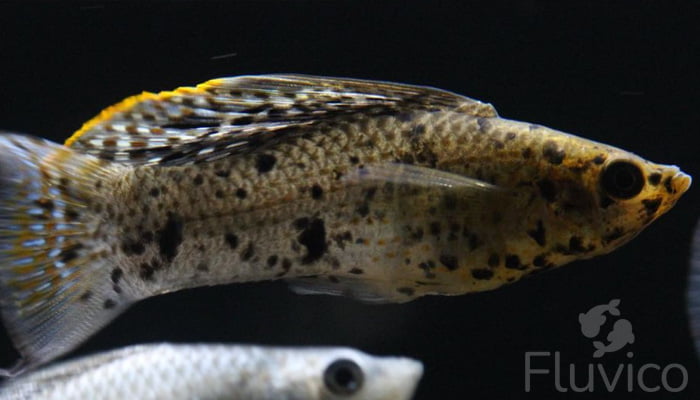
Lighting, Filtration and heating
Lighting:
- Livebearers generally require moderate lighting levels. Too intense light can cause stress and promote excessive algae growth.
- Use aquarium-specific LED or fluorescent lights for best results. The lighting schedule should mimic a normal day-night cycle, about 8-10 hours of light per day.
Filtration:
- High-quality filtration is crucial to maintain clean and healthy water, as livebearers can be sensitive to ammonia and nitrate build-up.
- Choose a filter with a suitable flow rate for your tank size. Hang-on-back or sponge filters work well for livebearer aquariums.
- Regular maintenance of the filter is key to ensure it operates efficiently.
Heating:
- The optimal temperature range for most livebearers is between 70°F and 80°F. This can be maintained with a reliable aquarium heater.
- Choose a heater with a thermostat to maintain stable temperatures. Fluctuating temperatures can lead to stress and illness in livebearers.
- Ensure the heater’s wattage is appropriate for your tank size to provide consistent and even heating.

Diet & Breeding
Diet:
Livebearers typically have an omnivorous diet, consuming both plant and animal matter. Here are some feeding guidelines:
- High-Quality Flake or Pellet Food: This should form the basis of their diet, as it’s formulated to provide a balanced nutrition.
- Live or Frozen Foods: Offer live or frozen foods such as brine shrimp, daphnia, or bloodworms as occasional treats. They not only offer additional nutrients but also stimulate the fish’s natural hunting behaviors.
- Vegetable Matter: Depending on the species, some livebearers might enjoy bits of blanched vegetables like peas, zucchini, or spinach.
- Feeding Frequency: Usually, feeding them small amounts once or twice a day is sufficient. Aim for the amount that they can consume within 2-3 minutes to avoid overfeeding and potential water quality issues.
Breeding:
Livebearers are known for their ease of breeding. They’re called “livebearers” because they give birth to live young rather than laying eggs. Here’s what you should know:
- Sex Ratio: Maintain a higher ratio of females to males in the tank. Males can often harass females with their constant attempts to mate.
- Breeding Environment: Provide plenty of hiding spots for the females and the newborn fry. Dense plantings or specific breeding boxes can offer safe havens.
- Gestation and Fry: Gestation period varies by species but usually lasts around a month. After birth, separate the fry from adults to prevent them from being eaten.
- Fry Care: Feed the fry with specially formulated fry food or finely crushed flake food. They’ll grow rapidly if given the proper care and nutrition.

Compatible plants
Livebearers appreciate well-planted aquariums which provide cover, reduce stress, and for some species, offer a supplementary food source. Here are some plants compatible with livebearers:
- Anubias: This is a robust and slow-growing plant that requires minimal lighting. It has broad leaves that provide good cover for fish.
- Java Fern: This is an easy-to-care-for plant that can thrive in a wide range of conditions. It’s a great plant for beginners and can provide hiding spots for smaller fish and fry.
- Java Moss: Ideal for breeding tanks, java moss provides plenty of hiding places for fry. It’s a low-maintenance plant that can tolerate a wide range of water parameters.
- Amazon Sword: This is a larger plant that creates a great background in your aquarium. It requires moderate lighting and can provide a lot of cover.
- Vallisneria: This plant grows tall and is ideal for the back of your tank. It’s hardy and can withstand a wide range of water parameters.
- Hornwort: A fast-growing plant that can float or be planted in the substrate. It helps control nitrates and provides excellent cover for fry.
- Water Sprite: It can be grown floating or planted, providing different types of cover. It also helps control nitrates and is easy to care for.
When choosing plants, consider the specific needs of your livebearer species, as well as your tank’s lighting, substrate, and overall setup. Some livebearers might nibble on certain plant species, so choose plants that can withstand this or that grow quickly.
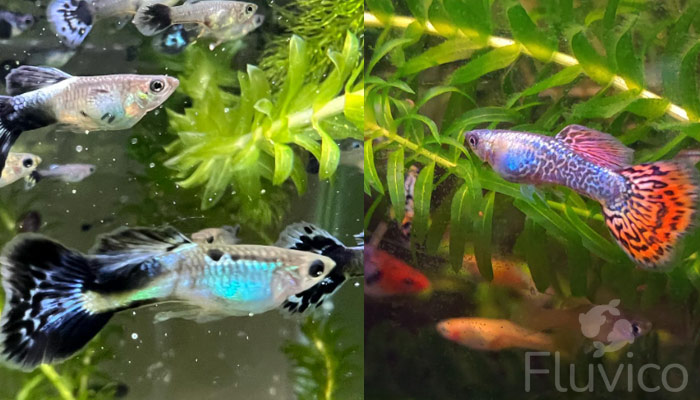
Aquarium Maintenance
Regular Water Changes:
- Conduct weekly or biweekly water changes, removing and replacing about 25% of the tank water each time. This helps maintain water quality by reducing the accumulation of harmful waste products.
Filter Maintenance:
- Clean your filter regularly according to the manufacturer’s instructions, but avoid over-cleaning as this can remove beneficial bacteria. Never clean the filter media with tap water, as chlorine can kill these bacteria. Use a bit of tank water instead.
Monitoring Water Parameters:
- Regularly test your aquarium water for pH, ammonia, nitrite, and nitrate levels to ensure they remain within safe ranges for your livebearers. Ideal water parameters can vary between species, but most livebearers prefer slightly alkaline water with a pH between 7.0 and 8.0.
Substrate Cleaning:
- Use a gravel vacuum to clean the substrate during your water changes. This removes uneaten food and waste that can accumulate and degrade water quality.
Algae Control:
- Algae growth is normal, but excessive algae can be a sign of imbalanced nutrients or lighting. Regularly clean the tank glass, reduce light exposure, and consider adding algae-eating creatures if algae become a problem.
Health Checks:
- Regularly observe your livebearers for signs of disease or distress, such as changes in behavior, color, or appetite. Early detection is key to successful treatment.
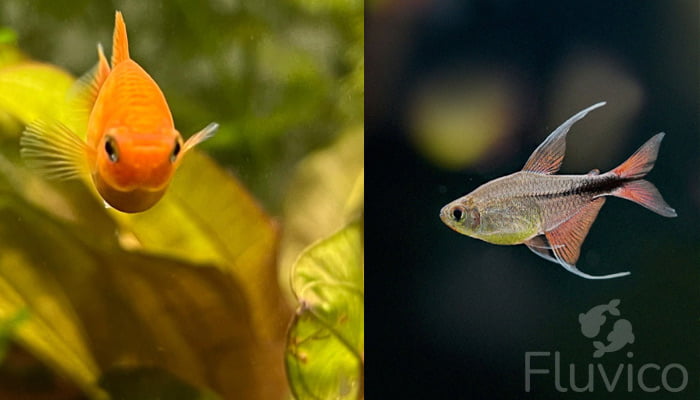
Livebearers and Tank Mates
Livebearers are generally peaceful and sociable, making them good candidates for community tanks. However, it’s essential to choose tank mates wisely to ensure a harmonious environment. Here are some suitable tank mates for livebearers:
- Other Livebearers: Guppies, mollies, platies, and swordtails can usually coexist peacefully. They share similar water parameter requirements and feeding habits.
- Tetras: Many types of tetras, such as neon tetras or cardinal tetras, make good tank mates due to their peaceful nature.
- Corydoras Catfish: These bottom dwellers are peaceful and won’t compete with livebearers for food or space.
- Small Loaches: Species like the kuhli loach can do well with livebearers.
- Dwarf Gouramis: These are peaceful fish that tend to stick to the middle and top water layers.
- Invertebrates: Snails and shrimps, like nerite snails or cherry shrimps, can also be suitable companions.
Tank Mates to Avoid
While livebearers can be compatible with many species, there are certain tank mates you should avoid to ensure the wellbeing of your fish:
- Large Predatory Fish: Any fish species that are large enough to eat your livebearers should be avoided. This includes larger cichlids, catfish, and certain types of predatory loaches.
- Fin-Nipping Species: Some fish species are notorious for their habit of nipping the fins of other fish. Barbs, particularly tiger barbs, and some types of tetras (like Serpae tetras) can harass your livebearers.
- Aggressive Species: Some species, such as certain cichlids, bettas, and pufferfish, can be aggressive and may stress or harm your livebearers.
- Competitive Bottom Dwellers: While many bottom dwellers like Corydoras catfish are peaceful and good tank mates for livebearers, avoid ones that are overly competitive for resources or territory, like Red Tail Black Sharks.
- Fish with Different Water Parameter Needs: Species that require significantly different water conditions, like Discus fish (which need warmer, more acidic water), should be avoided.
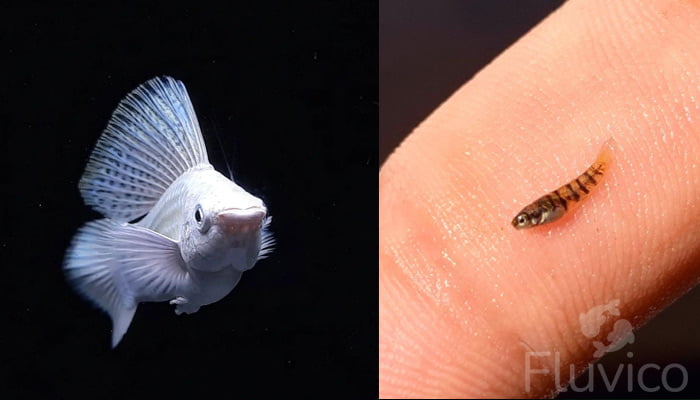
Livebearer Disease
Ich
Ich, also known as White Spot Disease or Ichthyophthirius multifiliis, is a common and highly contagious disease in aquarium fish, including livebearers. It’s caused by a protozoan parasite that invades the fish’s skin and gills.
Symptoms:
- White spots on the body, fins, and gills
- Frequent scratching or rubbing against surfaces
- Clamped fins, lethargy, and loss of appetite
- Respiratory distress (rapid gill movement)
Treatment:
- Quarantine: If possible, move the infected fish to a separate quarantine tank to avoid spreading the parasite.
- Medication: Treat the fish with an ich-specific medication available in pet stores or online. Always follow the manufacturer’s instructions for dosage and application.
- Temperature Increase: Gradually raising the aquarium temperature to 86°F (30°C) can speed up the life cycle of the parasite and make it more susceptible to treatment. Be careful, as not all fish species can tolerate this increase.
- Salt Treatment: For some freshwater fish, adding aquarium salt can assist in treatment. However, this is not suitable for all species.
Prevention:
- Quarantine new fish before adding them to your main tank.
- Regularly check water parameters to ensure they’re within appropriate ranges.
- Avoid sudden changes in water temperature or conditions.
- Keep the aquarium clean and don’t overcrowd it.
Fin Rot
Fin Rot is a common bacterial disease in aquarium fish, caused primarily by bacteria of the genus Aeromonas, Pseudomonas, or Vibrio. It typically occurs when a fish’s immune system is weakened, often due to stress, poor water quality, or physical injury.
Symptoms:
- Fraying or disintegration of the fins.
- Fins appear to have been eaten away or have white, milky edges.
- In advanced stages, the base of the fins may become red and inflamed.
Treatment:
- Improve Water Quality: Often, fin rot can be stopped and reversed simply by improving water conditions. Conduct regular water changes, monitor water parameters, and ensure your tank isn’t overcrowded.
- Quarantine: If one fish shows symptoms, consider moving it to a separate quarantine tank to avoid the spread of the disease and to facilitate treatment.
- Medication: Treat with a broad-spectrum antibiotic or a medication specifically designed to treat fin rot, such as those containing the active ingredient erythromycin. Always follow the manufacturer’s instructions for dosage and application.
Prevention:
- Regularly check water parameters to ensure they’re within appropriate ranges.
- Handle your fish as little as possible to prevent injury and stress.
- Provide a balanced diet to support fish health.
- Quarantine new fish before introducing them to your tank.
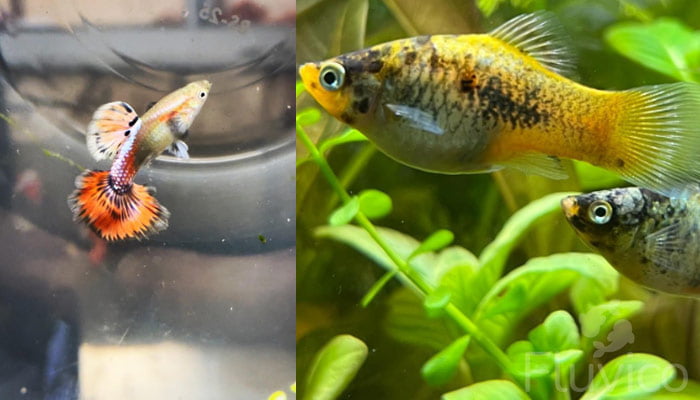
Velvet
Velvet, also known as Gold Dust Disease, is a parasitic infection in fish caused by the dinoflagellate parasites from the Oodinium genus. It’s a serious and highly contagious condition that can quickly spread through your tank if not promptly treated.
Symptoms:
- Fish appears to be dusted with gold, yellow, or rust-colored powder.
- Scratching or rubbing against surfaces.
- Clamped fins, lethargy, and loss of appetite.
- Respiratory distress (rapid or labored breathing) in severe cases.
Treatment:
- Quarantine: If only one or a few fish show symptoms, immediately move them to a separate quarantine tank to prevent the spread of the disease.
- Medication: Treat the fish with a medication specifically designed to treat Velvet, like copper-based medications or ones containing malachite green. Always follow the manufacturer’s instructions for dosage and application.
- Darkness: Velvet parasites rely on light to photosynthesize and grow, so covering your tank to keep it dark can help inhibit their lifecycle.
- Increase Temperature: Gradually increasing the water temperature can speed up the parasites’ lifecycle, making the treatment more effective. But be sure your fish species can tolerate this change.
Prevention:
- Quarantine new fish before adding them to your main tank.
- Regularly check water parameters to ensure they’re within appropriate ranges.
- Avoid sudden changes in water conditions.
Dropsy
Dropsy is a symptom rather than a specific disease itself. It is characterized by a swollen or bloated abdomen and is usually the result of a kidney infection. This causes the fish to retain fluid, leading to its characteristic ‘pinecone’ appearance as the scales stand out from the body.
Symptoms:
- Swollen or bloated body.
- Scales sticking out, creating a “pinecone” appearance.
- Eyes may appear bulging (exophthalmia).
- Loss of appetite and lethargy.
Treatment:
- Quarantine: Move the affected fish to a separate quarantine tank to avoid the spread of potential underlying diseases and to facilitate treatment.
- Antibiotics: Treat with a broad-spectrum antibiotic. Consult with a fish health professional to get a prescription and for advice on the correct usage and dosage.
- Epsom Salt Bath: Epsom salt baths can sometimes help draw out the excess fluids. Dissolve Epsom salt in dechlorinated water (1-3 tablespoons per 5 gallons of water), and let the fish stay in this bath for about 15-20 minutes.
Prevention:
- Maintain good water quality with regular water changes and proper filtration.
- Feed a balanced diet and avoid overfeeding to prevent constipation, which could potentially lead to bloating.
- Quarantine new fish before introducing them to your main tank.
Unfortunately, dropsy is often a symptom of advanced internal disease, and prognosis is usually poor once a fish starts exhibiting these signs. However, like all the above diseases, early detection and treatment can sometimes save a fish, especially if the underlying cause is treatable. If you’re unsure about any steps, don’t hesitate to consult with a fish health professional or a trusted local fish store.
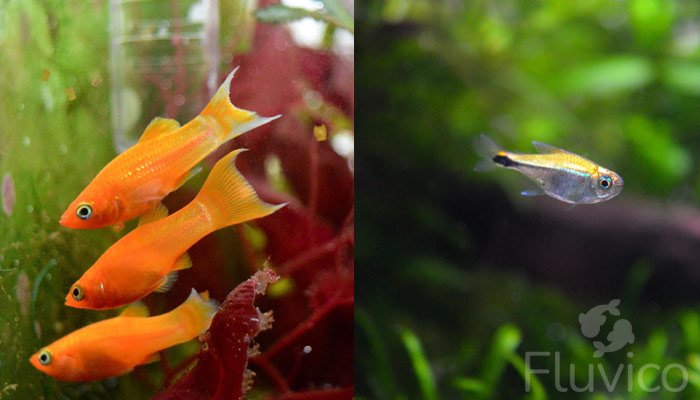
FAQ
What Do Livebearers Eat?
Livebearers are omnivorous, relishing a mixed diet that includes high-quality flake or pellet food, supplemented with live or frozen options such as brine shrimp, bloodworms, or daphnia. Occasional plant matter like blanched veggies also enhances their diet.
How often do Livebearers give birth?
Depending on the species, typically give birth every 4 to 6 weeks. The female can store sperm from a single mating for several months, allowing her to produce multiple broods without the presence of a male.
How many babies do Livebearing fish have?
The number of fry a Livebearing fish can produce varies greatly by species and individual size. On average, they can give birth to anywhere from 5 to 100 fry per brood, with larger females typically producing more offspring.
Which livebearers breed most?
Guppies are among the livebearers that breed most frequently, with females capable of producing a new brood every 4 to 6 weeks. Each brood can consist of anywhere from 20 to 200 fry, depending on the female’s size.
More Reading

15 Types of Cryptocoryne: Which is Best For Your Aquarium Setup?

16 Awesome Low Light Aquarium Plants (Mosses, Ferns & Stem Plants)


18 Types of Aquarium Moss: Photos, Care, Propagation & Growth Guide
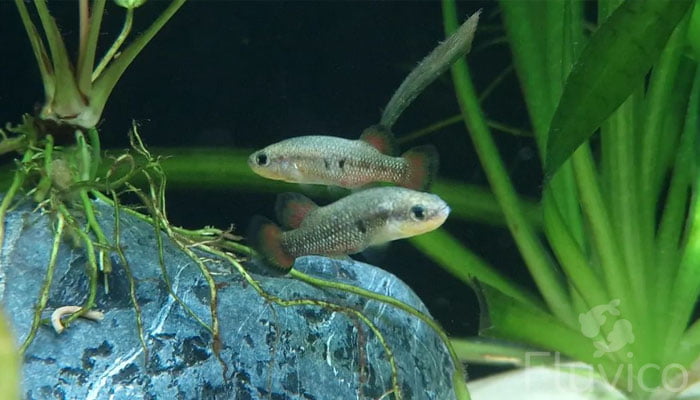

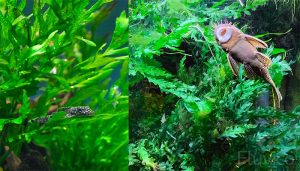


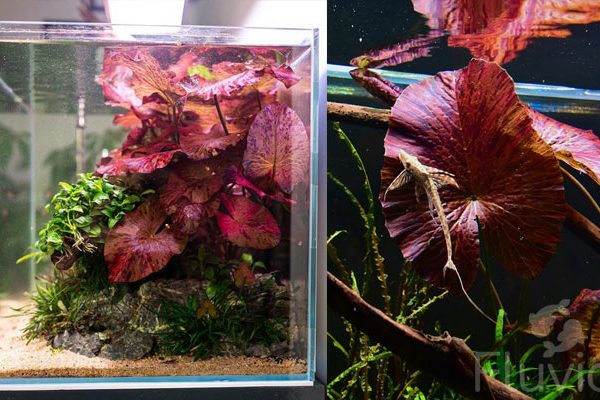
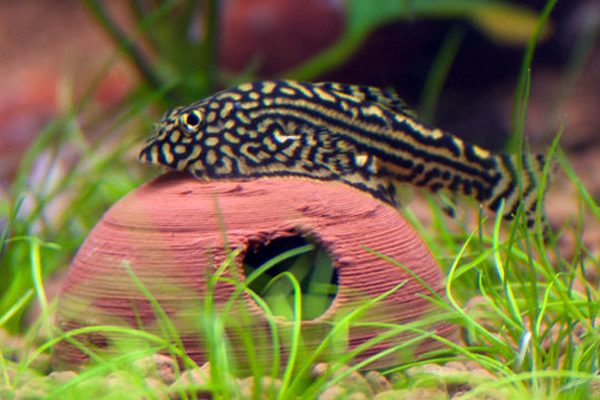
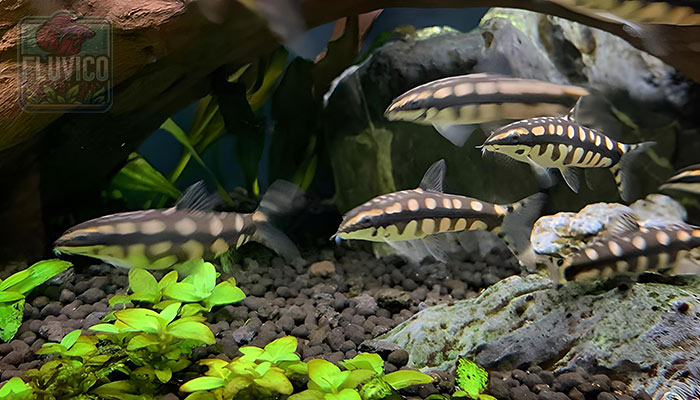
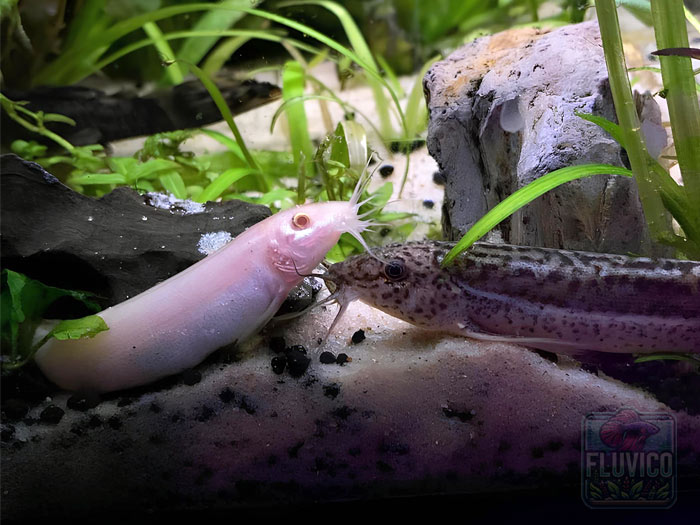
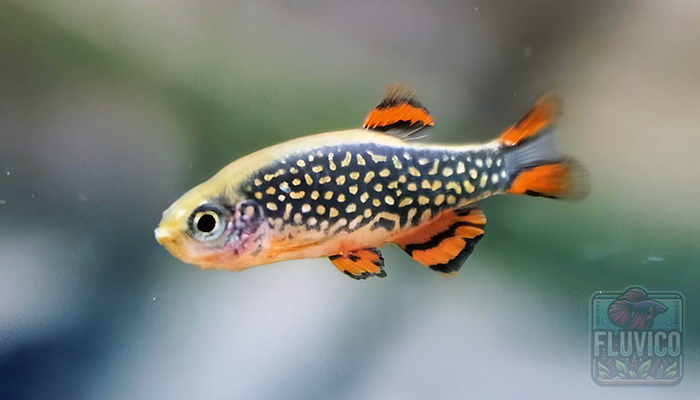
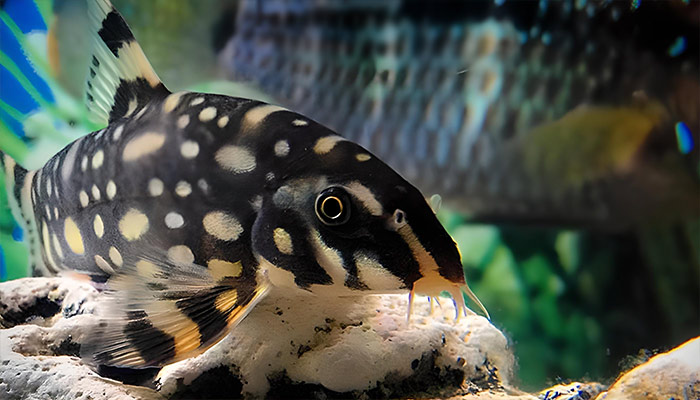
Hope you enjoyed our Livebearer Care Guide!
If you have any questions? Ask away, we’re here to help!
All the best,
Daniel